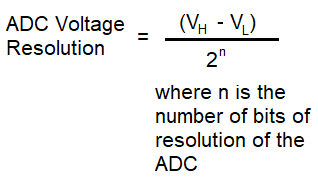ADC Voltage Resolution Calculator

This ADC Voltage Resolution Calculator calculates the minimum voltage that exists between bit resolutions in an ADC.
An analog-to-digital converter (ADC) is a device that converts a real-world analog signal and represents this signal as a digital voltage value.
This has limits, however. An ADC is limited by the number of bits of resolution.
Let's say, for example, that we are working with a 12-bit ADC.
212 is 4096 bits.
Let's say that the circuit we are dealing with has a high voltage of 5V and a low voltage of 0V.
This means that the voltage resolution would be, (5V-0V)/212= 5/4096= 0.001220703125V or 1.22mV.
What this means is that converted analog to digital signals can only increment or decrement in steps of 1.22mV (as the finest resolution).
Higher-resolution ADCs will have more narrow voltage resolutions.
Let's do the same calculation with a 16-bit ADC resolution.
216 is 65,536.
5/65,536 is 0.0000762939453125V or 76μV.
So between each bit of the ADC is a step of 76μV, much finer than the 1.22mV with the 12-bit ADC.
To use this calculator, a user simply enters in 3 values, VH, VL, and the number of bits of resolution of the ADC, and clicks 'Submit'. The resultant value will then be shown in units volts and either millivolts or microvolts.
VH must be greater than VL, or an error will occur.
The number of bits of resolution of the ADC must be a positive integer, or an error will occur.
Again, the ADC voltage resolution lets us know how many volts the ADC increments or decrements in
between bits of resolution.
Related Resources
Analog-to-digital (ADC) Conversion Calculator
Maximum Quantization Error for ADCs Calculator
